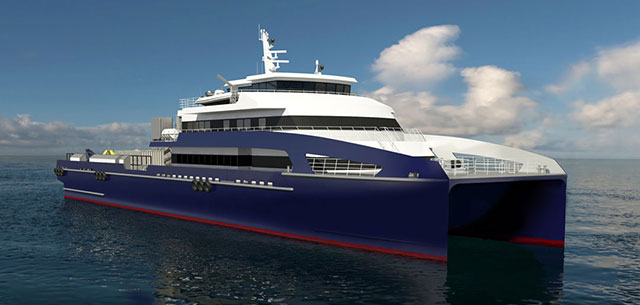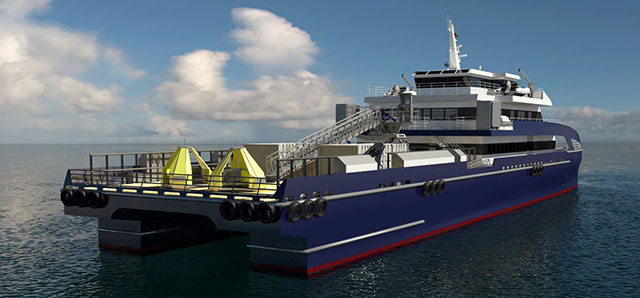Incat Crowther to Build 70m Catamaran Fast Crew Boat
Complete with a crew transfer system consisting of dynamic positioning equipment class (DP2) coupled with a stabilized access platform.
Incat Crowther is pleased to announce a first of type 70m Catamaran Fast Crew Boat (FCB), compliant with IMO HSC code and complete with a crew transfer system consisting of dynamic positioning equipment class (DP2) coupled with a stabilized access platform. Construction of the vessel has commenced at the shipbuilder Incat Tasmania, with delivery scheduled for September 2014.
The vessel will operate as a fast crew transfer vessel for 150 offshore workers to multiple offshore installations. The hull design has been optimized for high speed transits with specific features to limit the sea sickness of transiting offshore workers. The on-board noise, vibration and indoor climate is in accordance with DNV comfort class notation. The vessel is designed to operate in sea conditions of 40 knot wind and seas of 3m significant wave height.
The high speed of the 70m FCB allows operational cost efficiency over helicopter transfer for passengers and cargo, whilst the advanced design ensures the crew arrive at the platform fit for work.
Crew transfer is completed primarily by a stabilized access platform, providing a level platform and gangway to access the offshore platform from the vessel. The access platform compensates for the vessels motion by using 6 hydraulic cylinders. The vessel will hold station using dynamic positioning (DNV DYNPOS-AUTR), and in combination with the stabilized access platform, crew transfers will be performed in up to sea state 4.

This vessel is the first catamaran to utilize this system and the first to have the stabilized access platform structure and supporting systems integrated into the design. For redundancy and operations in higher sea conditions, a crane lifted personnel transfer system is provided for up to 2 groups of 9 offshore workers.
Whilst the primary function of the vessel is crew transfer, the vessels arrangement provides flexibility with over 100 square meters of cargo deck, rated at 2t/m2. This capacity will allow the vessel to complete cargo hot shots for up to 110 tonnes of specialized equipment to a range of 300nm at speeds up to 35 knots.
The vessel is under construction at the Incat Tasmania shipyard, with the design by Incat Crowther and production engineering by Revolution Design. The final product incorporates key experience and strengths by each of the parties involved. Incat Tasmania has the specialized facilities, construction methodologies and experience of very large aluminium catamarans. Revolution Design has incorporated the production engineering design techniques optimized over multiple build projects at Incat Tasmania.

The shipyard’s construction capability and capacity has leveraged into this market with the oil and gas design
experience of Incat Crowther; utilizing the track record obtained from the design of the SEACOR CrewZer class
fast catamaran crew boats. This class of vessel dates back to 2007, with the first of class vessel SEACOR Cheetah. The latest vessel in this class, SEACOR Leopard, has just completed sea trials in the US. Incat Crowther has over 90 vessels operating or under construction for the world-wide oil and gas market, which includes eight Incat Crowther-designed crew boats currently operating in the Caspian Sea.
The high level of passenger comfort on the 70m FCB will be achieved by the vessel’s advanced semi-SWATH hull form, combined with a resiliently mounted main cabin and superstructure and active ride control system consisting of T-Foil, interceptors and yaw stabilisers.
Passengers are accommodated on both the main deck and mid-deck, with the mid-deck featuring crew accommodation for 14. All crew cabins are ILO-compliant. The main deck also features VIP rooms, vending machines, luggage space and a large workshop.
The aft cargo deck measures in excess of 400 square meters; housing the stabilized access platform, dedicated landing area for the crane lifted personnel transfer system, as well as 10’ luggage containers and hot shot cargo area.
Four MTU 16V4000 engines will power the vessel driving Hamilton HT-900 water jet propulsion with a service speed of 30 knots at full load condition and 90% MCR in sea state 4. Four azimuthing drop-down thrusters forward will take care of maneuvering, with the vessel having DP-2 equivalent DNV classification.
Safety of operation and environmental protection is a high priority; subsequently the environmental impact of the vessel’s emissions to air, discharges to sea, deliveries to shore from the vessel and protection against accidents are controlled and designed in accordance with environmental class. The safety of vessels operation is prioritized by the bridge design and navigational equipment compliance with nautical safety class.
The new crew transfer vessels will be delivered to Caspian Marine Services Ltd (CMS) in Baku, Azerbaijan, via a transit through the Volga-Don Canal. Once deployed, CMS will operate the vessels, providing crew transfer and hot shot cargo services to platforms in such fields as Azeri-Chirag-Deepwater Gunashli (ACG), the largest oil field in Azerbaijan sector of the Caspian Sea and Shah Deniz (a large offshore gas and condensate field). The oil and gas produced from these fields is transported by tanker for processing in Baku, and then transported via pipeline through Georgia and Turkey to the Mediterranean port of Ceyhan or the Georgian port of Supsa in the Black Sea.
The products and services herein described in this press release are not endorsed by The Maritime Executive.
